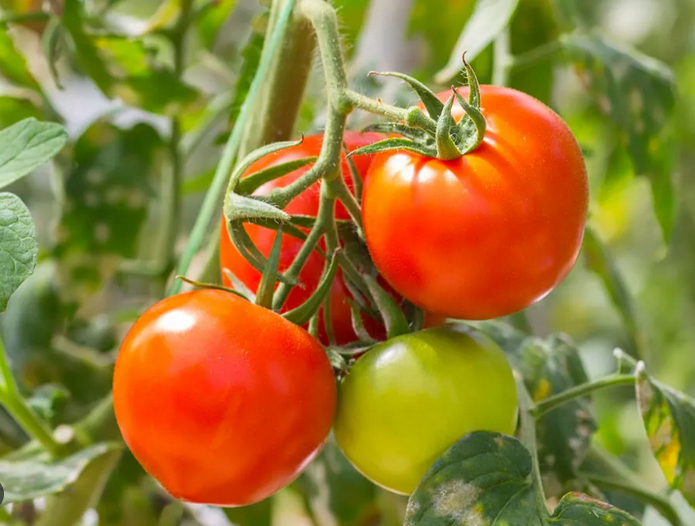Posted On: November 11, 2024
Posted By: KSNM DRIP

Tomato farming is very important in India. But growing tomatoes is becoming difficult and costly for farmers. The weather is often unpredictable, and water is sometimes hard to get. Because of this, many farmers are now using drip irrigation to water their plants. Drip irrigation helps give just the right amount of water directly to the roots, which makes the plants grow better and saves water. This is helping farmers grow more tomatoes with less effort and cost.
During 2022-23 India produced 208.19 lakh tonnes of tomatoes, the prices have been going high due to less number of farmers sowing tomato seeds. The diverse climatic conditions make it harder for farmers to cultivate tomatoes easily.
Growth Cycle Needs: Tomatoes require 400–600 mm of water over 90–120 days after transplanting.
Daily Irrigation: In greenhouses, daily needs range from 0.09 to 1.04 liters per plant, depending on setup.
Efficiency: Well-managed systems can reduce water use to 4 litres per kg of tomatoes, compared to 300 litres in poorly managed fields.
Ideal Temperature: 20°C to 30°C (68°F to 86°F).
Sunlight: Requires 6–8 hours of direct sunlight daily.
Evapotranspiration: Adjust irrigation based on regional evapotranspiration (ET) and crop growth stages.
Preferred Soil: Loam or sandy loam, which offers good drainage and moisture retention.
Root Depth: Roots can reach up to 1.5 meters deep, with primary water uptake within the top 0.7 to 1.5 meters.
Sensitivity: Tomatoes are moderately sensitive to salinity.
Yield Impact: Yield decreases by ~10% if soil salinity exceeds an electrical conductivity (ECe) of 3.5 mmhos/cm.
Drip irrigation is the ideal method for watering tomatoes. It delivers water directly to the roots, reducing waste and preventing plant diseases. This method promotes healthy growth and higher yields by keeping leaves dry and controlling water use. For efficient tomato farming, drip irrigation is both effective and sustainable.
Drip irrigation offers a range of benefits for tomato farming, supporting productivity and sustainability. Here’s how:
Reduced Water Use: Direct delivery to roots minimizes evaporation and runoff, achieving 90-95% efficiency.
Precise Application: Small, frequent watering meets plants’ exact needs, preventing water stress.
Higher Yield: Drip irrigation can boost yields up to 48% by reducing evaporation losses.
Enhanced Nutrient Uptake: Fertigation with drip irrigation improves nutrient delivery and quality, even increasing sugar content.
Lower Disease Risk: Drip irrigation keeps foliage dry, reducing fungal and bacterial diseases, particularly in humid climates.
Reduced Emissions: Subsurface drip irrigation can lower nitrous oxide emissions by up to 70%.
Soil Health: Drip systems prevent erosion and soil compaction, promoting sustainable soil health.
Cost Savings: While installation can be costly, long-term savings are achieved through reduced water and energy use, improved yields, and streamlined fertilizer application.
If you are about to plant coffee, then you don’t have to change the layout of the drip irrigation system, because the same tomato can be used for coffee, for more information you can go to Drip Irrigation for Coffee Plantation in India.
Plan the Layout: Start by designing a layout that covers all planting rows. Tomato plants need consistent water, so ensure the drip lines will reach each plant’s root zone.
Choose the Right Components: Select a mainline pipe, drip tubing, emitters, connectors, filters, and a pressure regulator. A timer is also helpful for automating irrigation schedules.
Prepare the Site: Clear the area of debris and weeds. Level the soil if necessary to ensure even water distribution.
Install the Mainline: Lay the mainline pipe along the edge of the field. This will distribute water to the drip tubing.
Lay Out the Drip Tubing: Connect drip tubing to the mainline, spacing the emitters according to tomato plant placement, typically 12-18 inches apart.
Set Up Filtration and Pressure Regulation: Connect a filter to prevent clogs and a pressure regulator to maintain optimal water flow.
Test the System: Turn on the water and inspect for leaks. Check that each emitter is delivering water consistently.
Monitor and Adjust: Regularly inspect the system for blockages or damage, adjusting as needed, especially during critical growth stages of the tomatoes.
By following these steps, you can ensure efficient, targeted watering, promoting healthier tomato plants and higher yields with minimal water waste. You can also check out these 10 Easy Steps to Installing a Drip Irrigation System and install drip irrigation to your tomato farm.
Using drip irrigation for tomato farming is a smart and easy way to save water and improve crop quality. It gives the plants enough water without wasting any. This method also keeps the soil healthy. By using drip irrigation, farmers can grow better tomatoes, save money, and make their work easier in the long run.